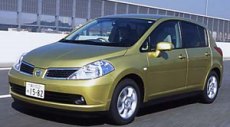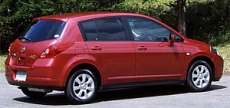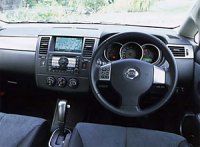|
 Despite
of its great financial success, to be
honest, I am not convinced with the cars created by Nissan in the era
of Carlos Ghosn. In my opinion, his emphasis on low cost made most
Nissan cars too average - average quality, average market
positioning, lack of innovations and free of risks. In other words,
boring. You might argue that it has 350Z, but then again Nissan used
to have 300ZX twin-turbo, Skyline GT-R and Pulsar GTi-R. And if it
wanted, it could have put the dream car Mid-4 into production as
well. Despite
of its great financial success, to be
honest, I am not convinced with the cars created by Nissan in the era
of Carlos Ghosn. In my opinion, his emphasis on low cost made most
Nissan cars too average - average quality, average market
positioning, lack of innovations and free of risks. In other words,
boring. You might argue that it has 350Z, but then again Nissan used
to have 300ZX twin-turbo, Skyline GT-R and Pulsar GTi-R. And if it
wanted, it could have put the dream car Mid-4 into production as
well.
Admittedly, when comes to
the
bread-and-butter
Sunny / Sentra / Almera, Nissan used to play it safe. However, under
the guidance of Le Cost Killer, today it plays even safer. This can
be easily seen in the new Tiida.
Tiida is the successor to
Sunny. At first you
might think Nissan sacrificed the long-serving Sunny nameplate in
pursue for a new image, but then you realize "Tiida"
actually means "the sun" in a Japanese dialect. New bottle,
old wine.
 Tiida
comes in 2 body style - a boring 5-door
hatchback and an even more boring 4-door sedan called "Tiida
Latio". Two cars are basically the same except the boot and the
rear seat. The rear seat of the hatchback can slide back and forth
for 24 cm to vary luggage space from 289 to 463 litres. In contrast,
thanks to the big boot (467 litres), the sedan does not need sliding
rear seat. Tiida
comes in 2 body style - a boring 5-door
hatchback and an even more boring 4-door sedan called "Tiida
Latio". Two cars are basically the same except the boot and the
rear seat. The rear seat of the hatchback can slide back and forth
for 24 cm to vary luggage space from 289 to 463 litres. In contrast,
thanks to the big boot (467 litres), the sedan does not need sliding
rear seat.
You might find the
hatchback
look like a Renault
Megane. In fact, the Tiida is not built on the Megane platform (note:
sorry for my earlier mistake) but on the Renault-Nissan group's
B-platform which gave birth to March, Cube, Note, Renault Modus and
Clio III. These cars
share high percentage of components thus allows the group to source
components globally at lower prices, because the
quantity they purchase is multiplied. On the down side, Le Cost Killer
killed not only cost but also the individual character of Nissan's
biggest selling car.
It would have been better
if
Tiida look as stylish
as Megane, but it isn't. One thing Tiida did proved: Renault design
boss Patrick Le Quement is really a genius. Based on the same size, he
can shaped a masterpiece while Nissan's sculptors
resulted in something this boring. Car design is really a magical
thing.
 If you
are not convinced, listen another story: do
you know why one year after its launch in Japan the Tiida still
hasn't landed the USA market? rumor said that earlier this year
Nissan showed the car to some selected American families secretly to
test reaction. The feedback about its styling was very bad thus
Carlos Ghosn ordered a restyle before it can go on sale in the USA.
(Update on 2005-10-05: eventually, Nissan cannot wait any longer
and it decided to export the Tiida to USA with little facelift and a
new name "Versa". However, the Versa is not going to replace the old
Sentra. A larger new Sentra will be introduced within 2 years.) If you
are not convinced, listen another story: do
you know why one year after its launch in Japan the Tiida still
hasn't landed the USA market? rumor said that earlier this year
Nissan showed the car to some selected American families secretly to
test reaction. The feedback about its styling was very bad thus
Carlos Ghosn ordered a restyle before it can go on sale in the USA.
(Update on 2005-10-05: eventually, Nissan cannot wait any longer
and it decided to export the Tiida to USA with little facelift and a
new name "Versa". However, the Versa is not going to replace the old
Sentra. A larger new Sentra will be introduced within 2 years.)
Still not convinced ?
listen
one more story: half
a year since Tiida went on sale in Hong Kong, I saw it just once on
public streets. During the same period, I saw a dozen Porsche 997
Carrera S, a couple of Lamborghini Gallardo, a Porsche Carrera GT, a
Ferrari F50…. you can see how unpopular it is.
The B-platform is never
outstanding. It employs struts and torsion-beam suspensions and
electric power steering just like any cost conscious European family
hatches. Converting it to the taste of Japanese made it even more
unremarkable - very light steering totally lacks feel, very soft
suspensions lead to a lot of body roll, and the rear drum
brakes lack stopping power. The way it drives is as boring as the way
it looks.
The engine and
transmission are
a little better,
but still fall in the average category. Nissan says the newly
developed HR15DE engine has all-alloy construction and special
treatment to reduce friction and improve thermal efficiency, but it
has neither variable valve timing nor variable intake manifolds. On
paper the 1.5-litre 16V engine delivering 109 horsepower is quite
remarkable, but by JIS standard that is only average. On the road,
the engine runs quite smoothly, but not particularly eager or
refined. At higher rpm it sounds rather noisy. Transmission is
similarly uninspiring. Tiida employs a CVT transmission as standard.
Although it has no much rubber band effect, it has no manual mode to
excite its driver either.
 After
all those average performance, we finally
found an outstanding area of Tiida: cabin space. And this is really
outstanding. Nissan said the cabin of Tiida is by far the biggest in
the class. From the throttle pedal to the rear seat the total length
of the cabin is 2035 mm. What does that mean? you will be amazed by
comparing this with its rivals: Toyota Corolla (1915 mm), Honda Civic
sedan (1865 mm), Mazda 3 (1825 mm)…. it even matches the current
Infiniti Q45 !!! besides, its cabin height is also the largest in
class. No wonder Tiida's back seat feels super-roomy ! passengers
have enormous legroom and headroom matching or even surpassing cars a
class above ! After
all those average performance, we finally
found an outstanding area of Tiida: cabin space. And this is really
outstanding. Nissan said the cabin of Tiida is by far the biggest in
the class. From the throttle pedal to the rear seat the total length
of the cabin is 2035 mm. What does that mean? you will be amazed by
comparing this with its rivals: Toyota Corolla (1915 mm), Honda Civic
sedan (1865 mm), Mazda 3 (1825 mm)…. it even matches the current
Infiniti Q45 !!! besides, its cabin height is also the largest in
class. No wonder Tiida's back seat feels super-roomy ! passengers
have enormous legroom and headroom matching or even surpassing cars a
class above !
Look at the spec sheet,
you
will find the Tiida
has just an average wheelbase of 2600 mm. How can it achieve that
amount of interior space ? from starter, its engine and transmission
are designed to be as slim as possible so that the engine compartment
can
be reduced, pushing the firewall forward. This free up the front
passenger space. At the back, the Tiida employs a slightly narrower
rear seat which can be slotted between the rear wheels. This
contributes to most of the additional space, although shoulder room
suffers a little. Predictably, the luggage space is sacrificed.
Therefore the hatchback Tiida offers a sliding rear seat to
compensate.
Apart from space, the
cabin is
pretty well
trimmed. The plastics are soft-touch ones and most surfaces are
covered with soft padding. The dashboard design emphasis living room
ambience, using high-quality faux wood to resemble Japanese
furniture, a strategy started by big brother Teana / Cefiro.
Unfortunately, the materials and switch gears fail to deliver the
solidity and ultimate quality feel as the best European hatchbacks.
The Tiida is an
accountant-driven car, a typical
Carlos Ghosn car. From the engine, transmission, suspensions,
steering to the packaging, everywhere has signs of cost concern. To
keep cost down and free of risk, it employs the most conventional
mechanicals and execute in the most predictable way (well, that
sliding rear seat is not an innovation actually, just copied from
various MAVs). Nissan is paying the price for being too conservative
this time. In the competitive market, innovative and fun-looking cars
always have an advantage over boring cars. Sometimes Carlos Ghosn can
be wrong. |